At Stonewall National Monument in Greenwich Village, lead ranger Julie Burna and supervisory park ranger Callie Tominsky stand by the Gay Liberation sculpture by American artist George Segal/Jennifer Bain
On the wet January day that I met National Park rangers Julie Burna and Callie Tominsky in Greenwich Village to talk about the first U.S. national monument dedicated to LGBTQ+ rights and history, we ducked into a coffeeshop to escape the drizzle and the relentless din of New York traffic.
Come June 28, the rangers will no longer be solely at the mercy of the elements and will be able to share the story of Stonewall National Monument from what’s going to be the first LGBTQ+ visitor center within the National Park Service.
For now, the door to 51 Christopher Street is locked and plastered with construction permits. The large picture window is blacked out so you can’t peek inside.
But the $3.2 million Stonewall National Monument Visitor Center — operated by Pride Live under an agreement with the NPS — is opening “strangely enough on time and oddly enough on budget,” promises founder Diana Rodriguez. A ceremony for donors and supporters will be live-streamed just before the center opens to the public at 2 p.m.
“I’m ready for people to see the space and experience and see what we have done,” Rodriguez tells me. “It is an older space so there is a lot of work we want to do because one of our goals is to be there forever.”
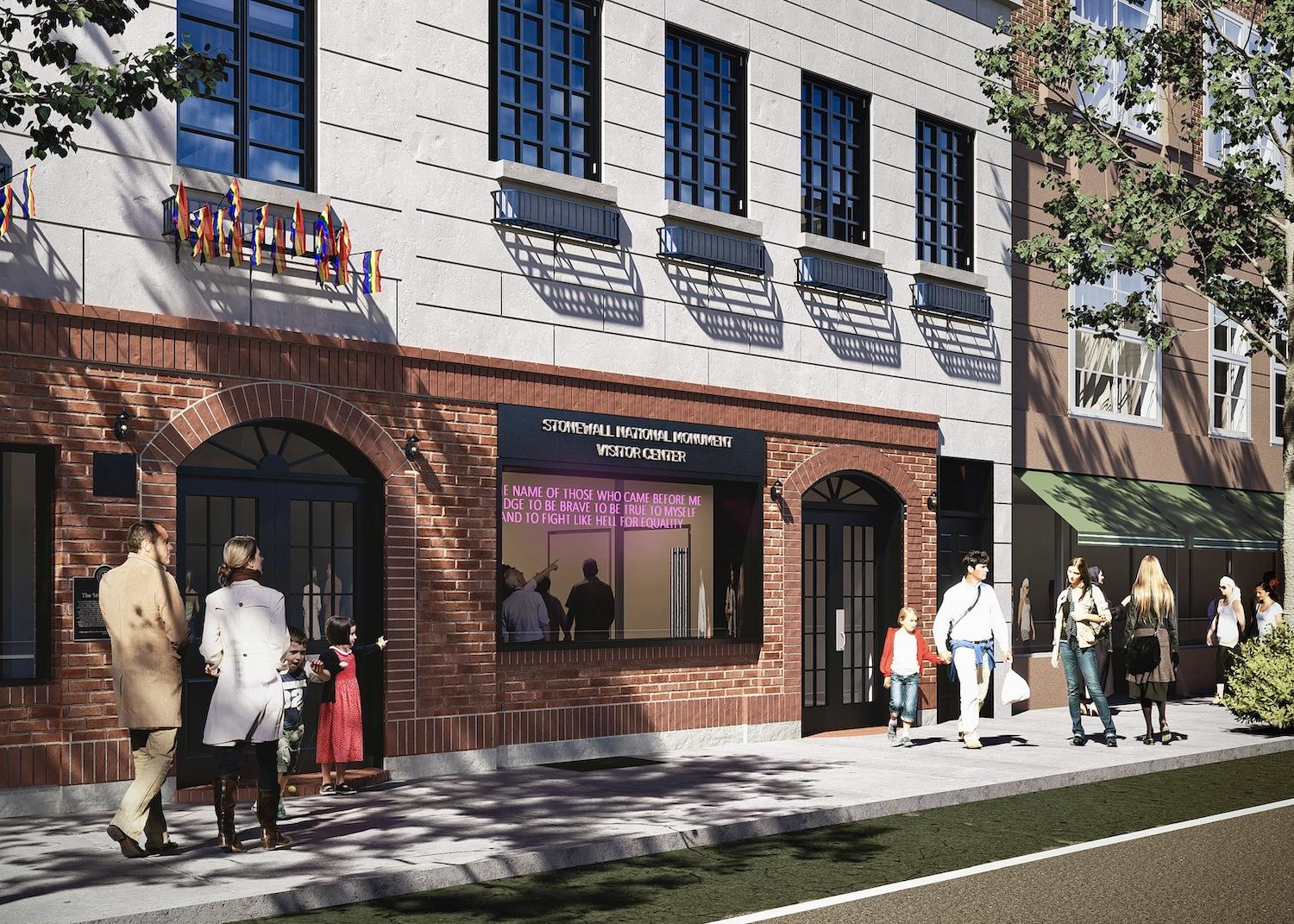
A rendering of what the exterior of the Stonewall National Monument Visitor Center is going to look like when it opens on June 28/EDG Architecture & Engineering
What Rodriguez can share is that there will be free entry to the 1,500-square-foot ground floor leased space. Rangers will be at the front counter along with NPS cancellation stamps. There will be a 40-seat theater and a retail shop. Interactive exhibits will include wall panels with first-hand accounts of the Stonewall Uprising curated by legendary social activist/journalist Mark Segal, and rotating work by Parsons School of Design students so that “young, queer voice and young allies” are involved. There’s room for storage on the lower level and a residential tenant upstairs.
“It will be a gathering place,” promises Rodriguez, “and that’s what we want at the end of the day.”
She grew up “very poor” in Jersey City and dreamed of exploring national parks. Just before COVID, she and her spouse finally took an epic national park road trip. When she was invited to the declaration ceremony for Stonewall and asked to consider creating this visitor center and partner with the NPS, she “jumped at the chance” and started capital fundraising.
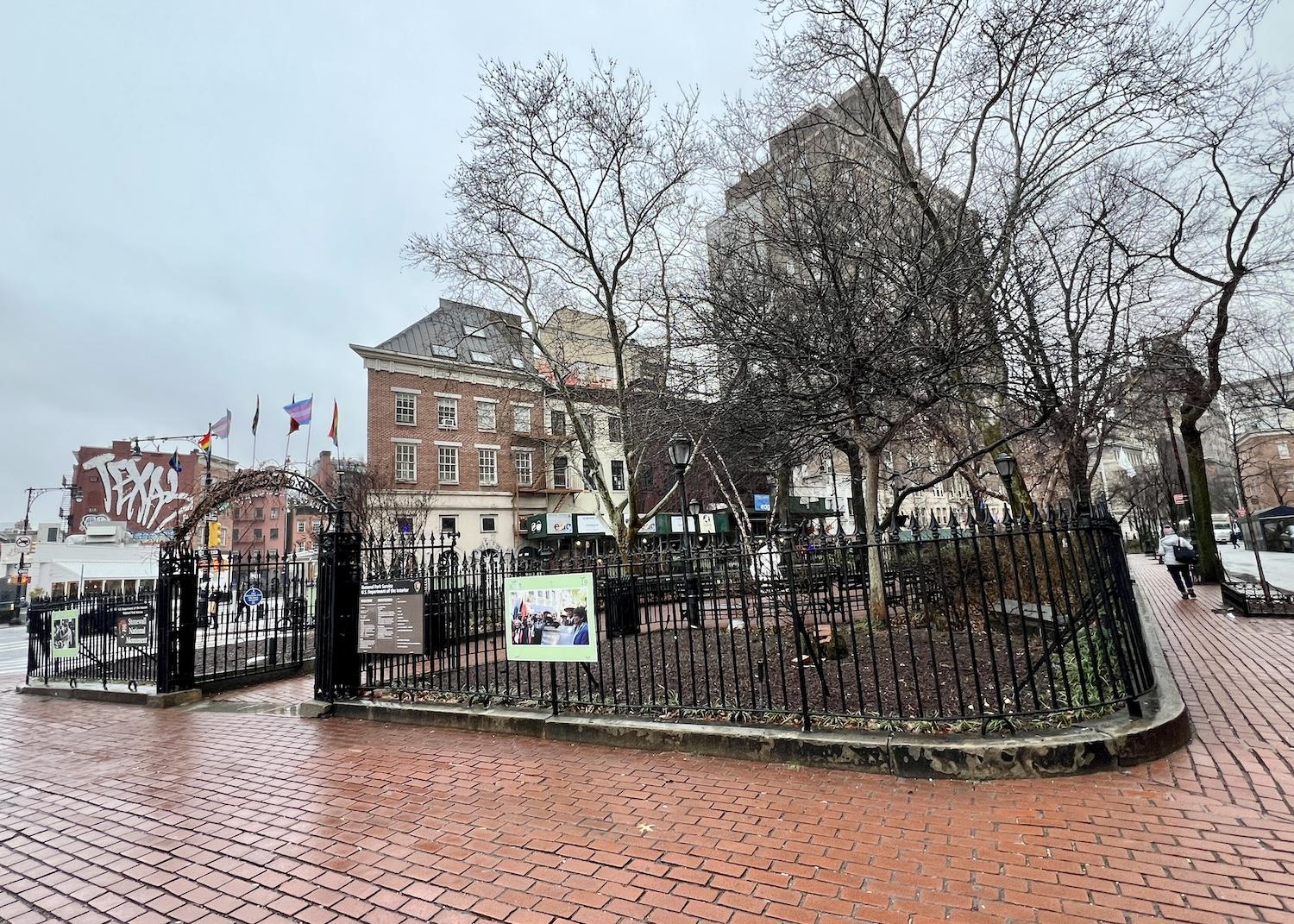
Stonewall National Monument is in what used to be known as Christopher Park in Greenwich Village/Jennifer Bain
Designated by President Barack Obama on June 24, 2016, the Stonewall National Monument is the first U.S. national monument dedicated to LGBTQ+ rights and history. It includes the 0.12-acre triangular park formerly known as Christopher Park and surrounding streets (including Christopher Street) and sidewalks.
The NPS calls the Stonewall Uprising the single most important spark that led to the modern LGBTQ+ civil rights movement. Before the 1960s, homosexuality was illegal in most states and people were frequently arrested for acts such as same-sex dancing, kissing or wearing clothes that didn’t correspond with their assumed gender. Police raided bars suspected of serving drinks to homosexuals. People lived in secrecy for fear of losing their jobs or being arrested.
On June 28, 1969, police raided the Stonewall Inn — then at 51-53 Christopher Street — but didn’t anticipate that the patrons, pedestrians and neighbors would spontaneously fight back for several days.
The NPS explains that until Stonewall, LGBTQ+ activism mostly mirrored tactics from the Civil Rights Movement — staged, non-violent protest such as picket lines, marches, sit-ins, lawsuits and letters. The uprising ushed in a controversial “out, loud and proud” approach and 50 LGBTQ+ organizations in America soon swelled to 1,500.
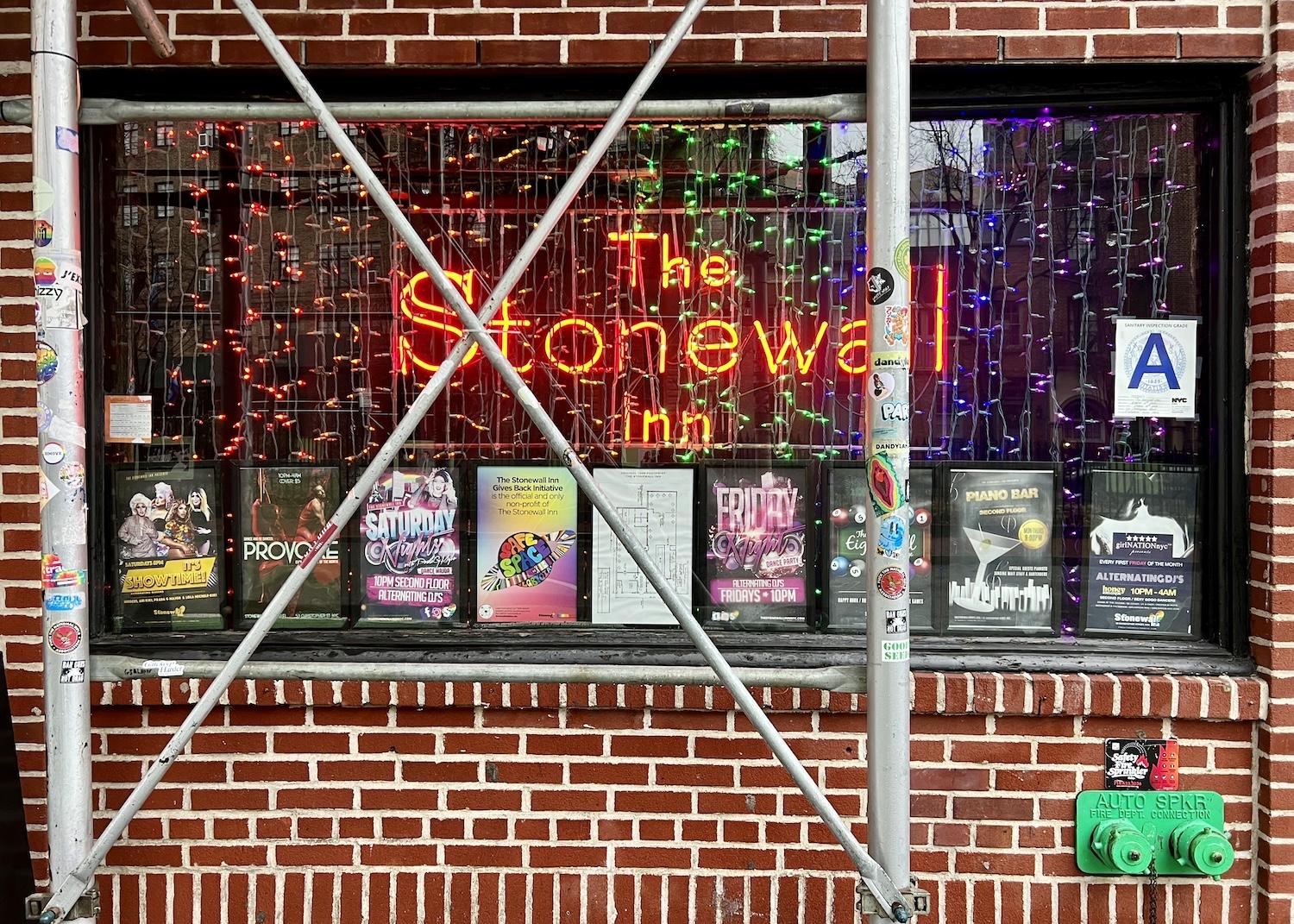
The Stonewall Inn is a privately operated bar at 53 Christopher St. across from Stonewall National Monument/Jennifer Bain
The Stonewall Inn was added to the National Register of Historic Places in 1999 and was named a National Historic Landmark in 2015. A reconnaissance survey then evaluated feasibility for joining the NPS.
The June 12, 2016 mass shooting at Pulse — a gay nightclub in Orlando — pressed home the need for a national park site dedicated to LGBTQ+ civil rights. Stonewall National Monument was designated less than two weeks later.
“Although the LGBT civil rights movement has made significant progress in the pursuit of equal rights and protections under the law, there is still more work to do,” the White House said in a news release. “As seen two weeks ago in Orlando, FL, LGBT Americans continue to face acts of violence, discrimination, and hate. LGBT people of color are especially at risk. The Administration is committed to continuing the fight for dignity, acceptance and equal rights for all Americans — no matter who they are or who they love.”
The monument encompasses both public and private property, including the privately owned Stonewall Inn, portions of the New York City street network and 0.12-acre Christopher Park, which was donated to the federal government by the City of New York.
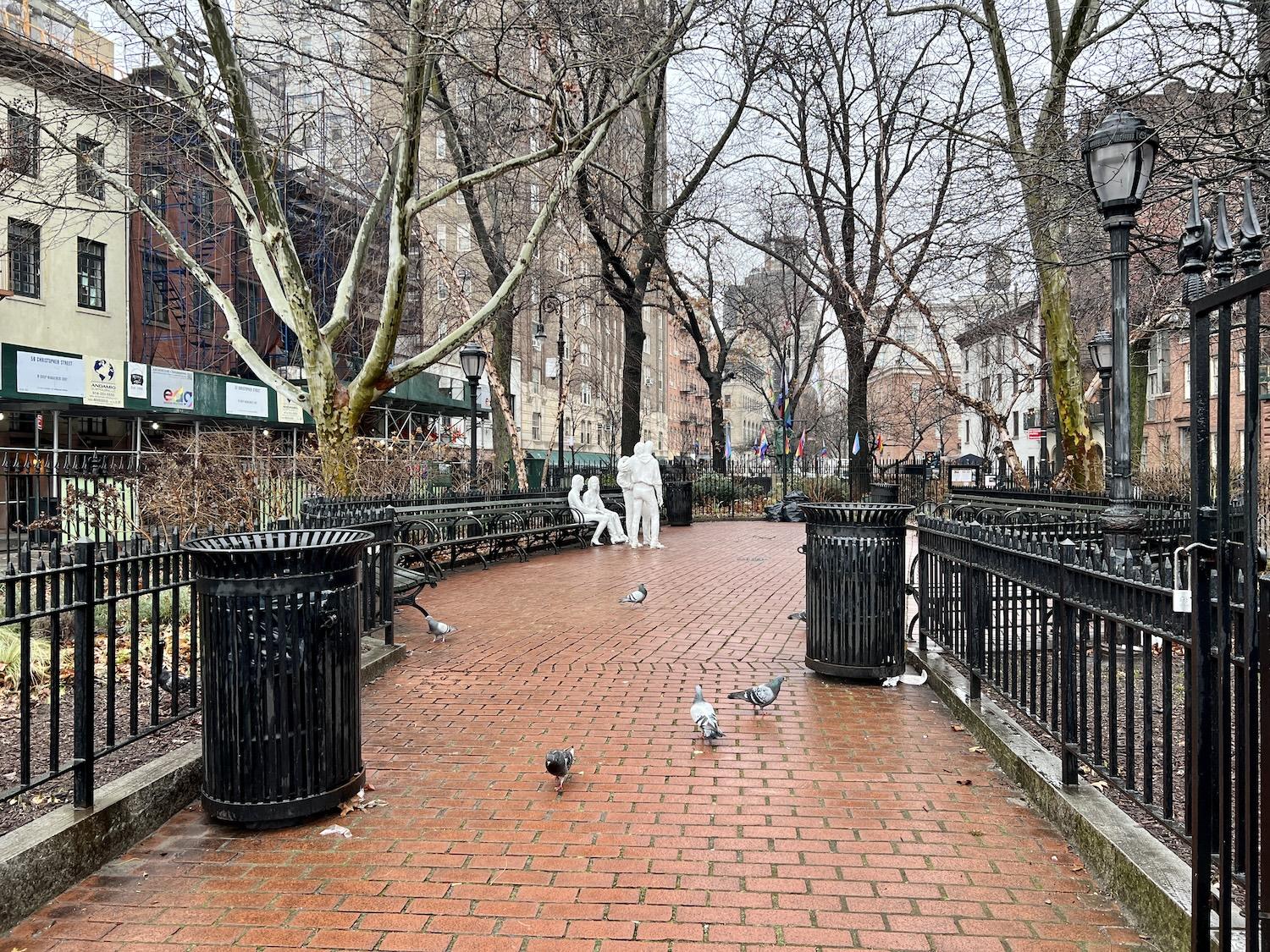
Stonewall National Monument is full of benches (and sometimes pigeons). George Segal’s sculpture Gay Liberation is a focal point/Jennifer Bain
As the 2019 Foundation Document points out, Christopher Park is one of the only public open spaces serving Greenwich Village west of 6th Avenue and has long been central to the life of the neighborhood and to its identity as an LGBTQ-friendly community.
The park was created in 1837 after a large fire in 1835 devastated an overcrowded tenement on the site. By the 1960s, the Foundation Document explains, the park was a destination for LGBTQ youth. It “served as a gathering place, refuge and platform to voice demands for LGBTQ civil rights” and “continues to be an important place for the LGBTQ community to assemble for marches and parades, including the annual NYC Pride, expressions of grief and anger, and celebrations of victory and joy.”
Across from the park, the Stonewall Inn (51-53 Christopher Street) was originally built in 1843 and 1846 as two separate two-storey horse stables. In 1930, the buildings were combined into one commercial space with a single exterior facade. In 1934, the first-floor space opened as a restaurant called Bonnie’s Stonewall Inn. The restaurant closed in 1966 and reopened in 1967 as a gay bar called the Stonewall Inn. Since the uprising, the space has changed owners and tenants multiple times. The first floor interior was divided into two individual commercial spaces in the early 1970s.
While 53 Christopher found its way back to being a bar, 51 Christopher was most recently a nail salon when Pride Live raised enough money to sign a lease for it in 2022 and began renovations. The plan was always to be a visitor center affiliated with the NPS, partly to avoid being confused with the American LGBTQ+ Museum that’s opening on the Upper West Side this year as part of the campus of the New-York Historical Society.
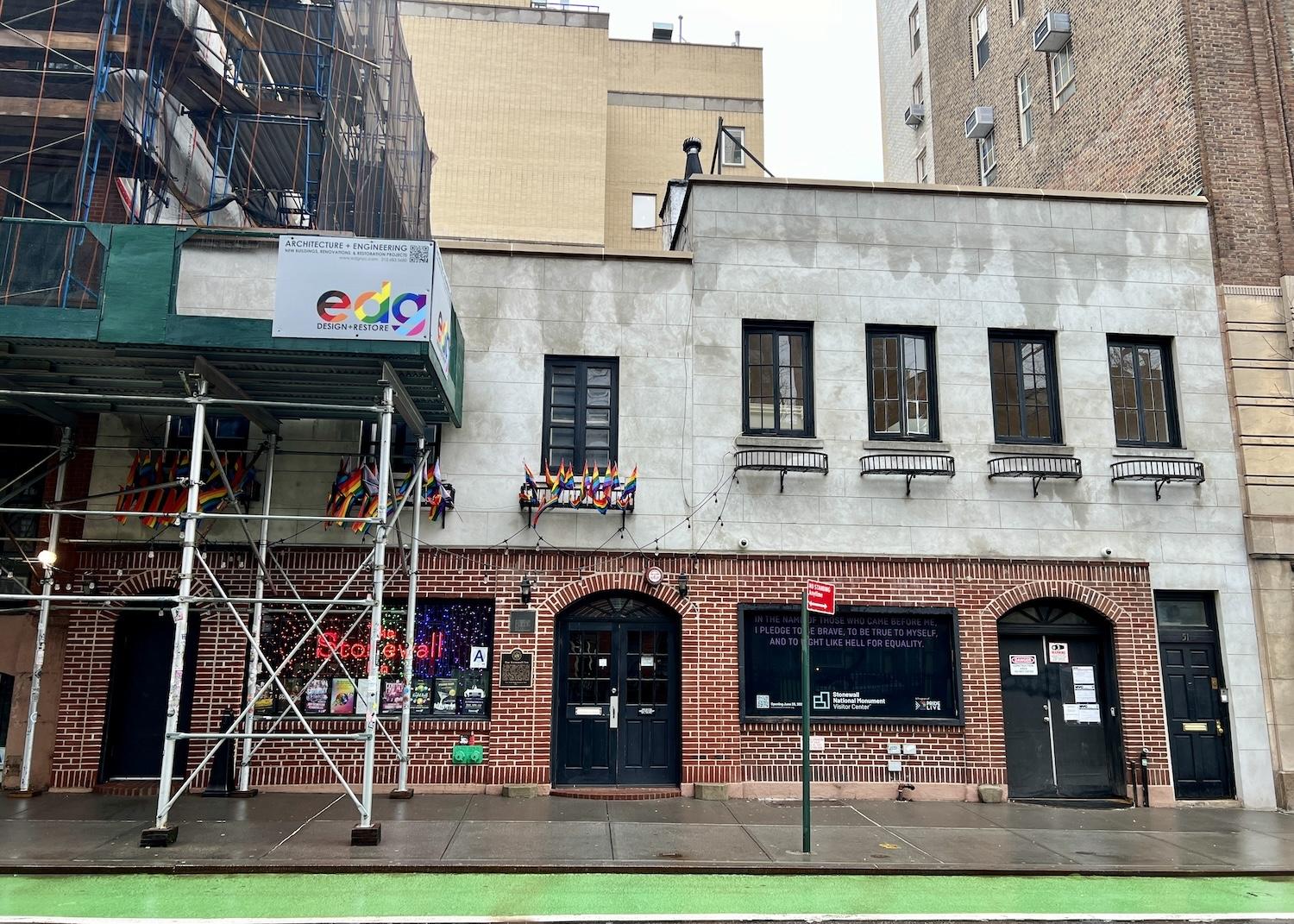
A view of construction for the Stonewall National Monument Visitor Center (to the right of the Stonewall Inn) as of January/Jennifer Bain
The ambitious goal for the visitor center was always to open on June 28, 2024 — the 55th anniversary of the uprising.
Christopher Park is now surrounded by brick sidewalks and a 19th-century wrought-iron fence with gated openings. Artist George Segal’s sculpture, Gay Liberation, is a focal point of the small plaza lined with brick pavers and benches. The statue shows four life-sized figures — two women and two men cast in white-lacquered bronze — and was commissioned in 1979 on the 10th anniversary of the uprising. When it was moved here in 1992, it reinforced the park as a site to interpret the uprising.
Today, LGBTQ+ people, allies and tourists make pilgrimages to the inn and the national monument, which is one of nine NPS sites in Manhattan, along with African Burial Ground National Monument. In 2022, Stonewall logged an estimated 1.58 million visits.
“Our visitors are very passionate and very protective of Stonewall,” says Burna, who is the lead ranger and Stonewall expert. “We’ve had people who have been engaged with the site since before it was national and they’re still caretakers today. And we do get the big fans of the park service. People describe it as a pilgrimage. [Park volunteer/caretaker] Steven Love Menendez calls it a spiritual place. It’s always been a meeting place. It was called the crossroads of three nations when the First People, the natives, lived here.”
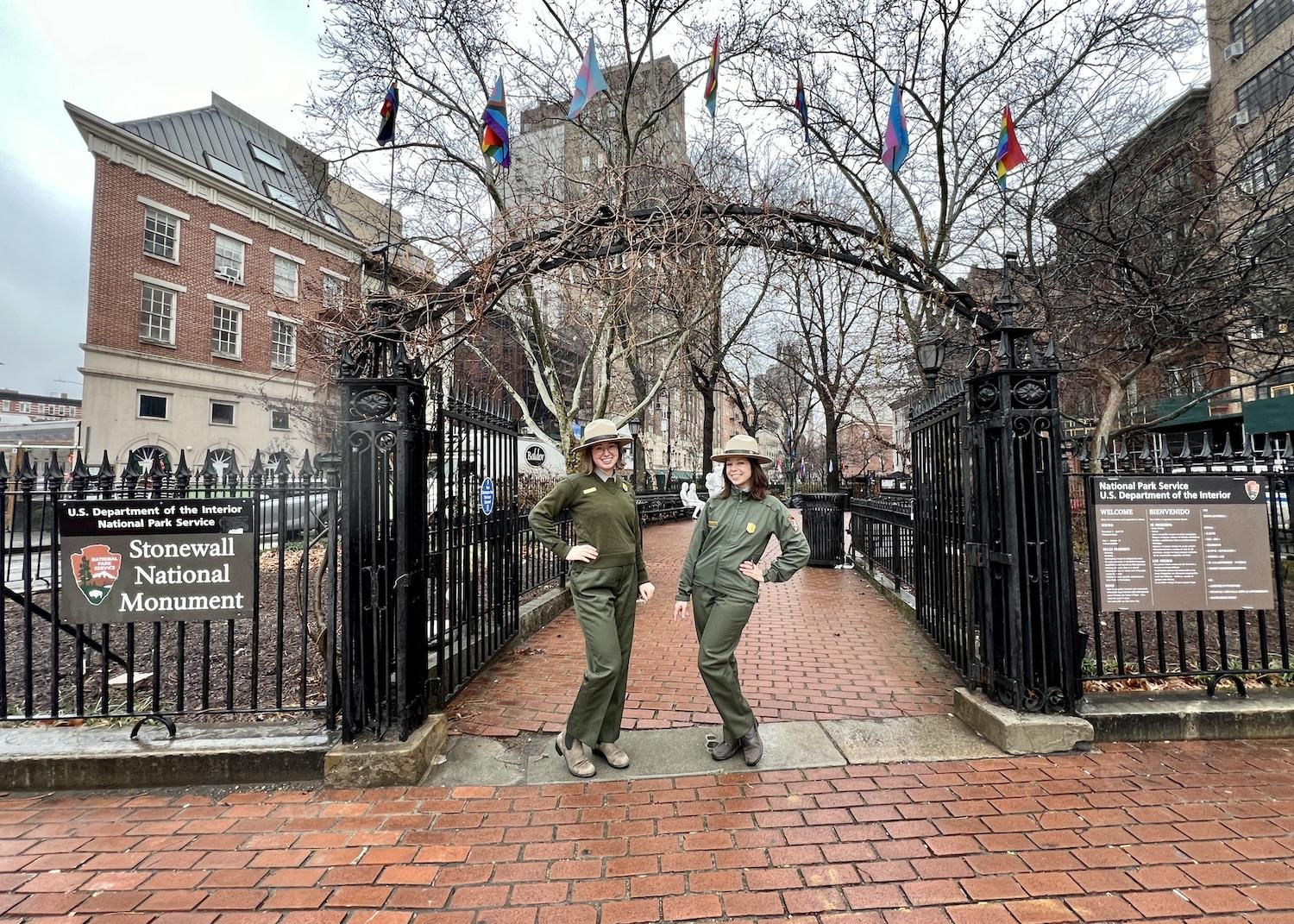
Supervisory ranger Callie Tominsky and lead ranger Julie Burna stand at the entrance arch to Stonewall National Monument/Jennifer Bain
I met Burna and Tominsky, the supervisory ranger, at the wrought-iron entrance arch.
The fenced park is open from about 7 a.m. to 5 p.m. (8 p.m. in the summer). The city unlocks the gates each morning and the park service locks them at night. The Christopher Park Alliance tends to the garden and planted a pink-flowering dogwood tree to commemorate the uprising’s 50th anniversary.
There’s a flagpole for the Rainbow Flag and a display about what all the diverse Pride flags mean. A rotating exhibit circles the fence, which currently presents historic photos and details about LGBTQ+ civil rights history.
This park-in-progress has most of the classic NPS amenities like Junior Ranger books and badges, cancellation stamps, education programs, website videos, exhibits, volunteer opportunities and virtual interpretation through social media.
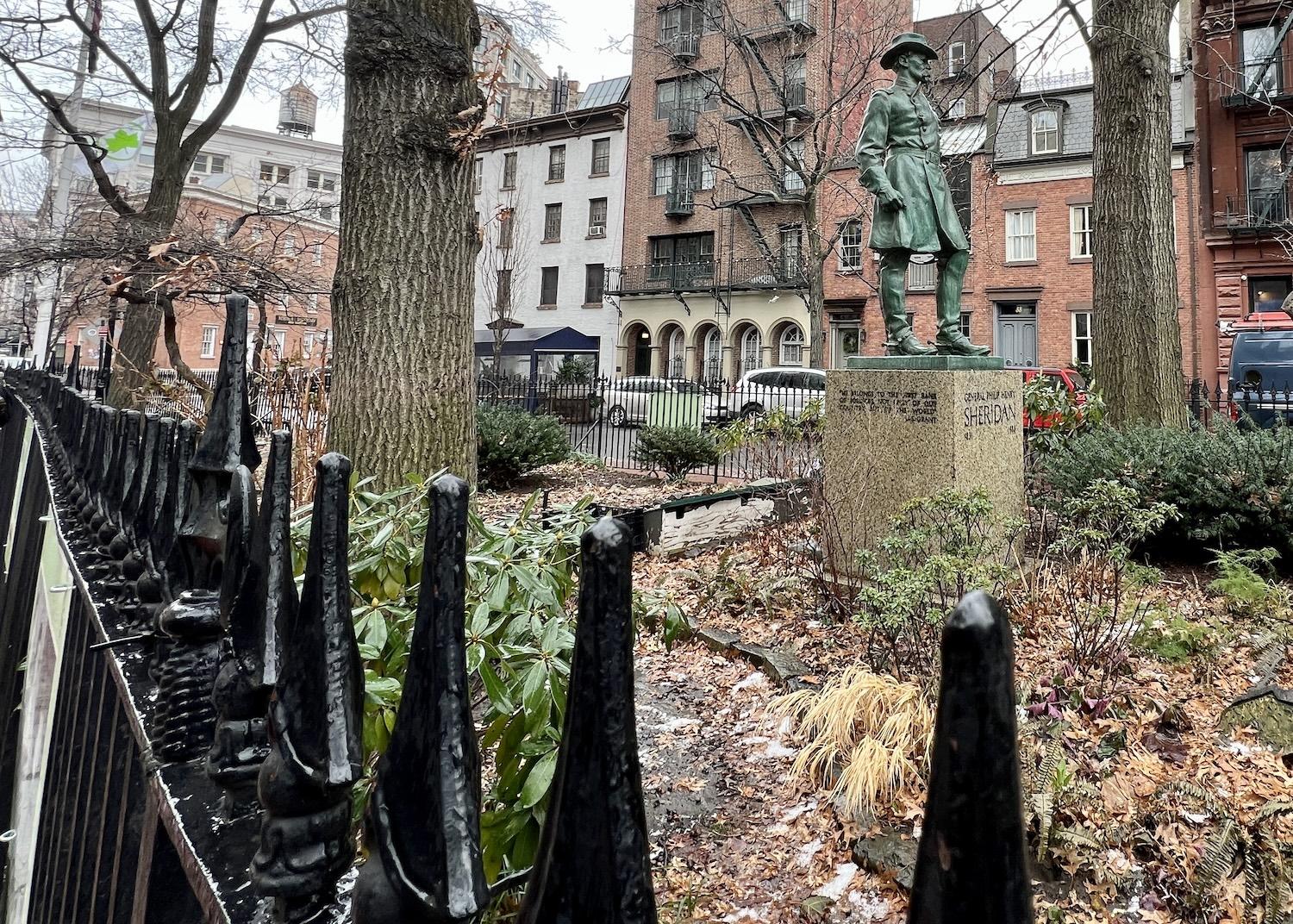
The statue of American Civil War General Philip Henry Sheridan was in Christopher Park before it became Stonewall National Monument/Jennifer Bain
One seeming anomaly is a bronze statue of American Civil War General Philip Henry Sheridan, a celebrated Union calvary leader clad in an officer’s uniform. Is he still relevant to park conversations?
Sheridan was here before the site transferred to federal hands, and locals even called the park Sheridan Square Park. Burna talks about Sheridan if people ask, and acknowledged that with a new national park site, there are questions like “what do we do with all of these conversations?”
While this is the first national park that’s dedicated to LGBTQ+ civil rights, Stonewall isn’t the first with a LGBTQ+ connection. “We really like to highlight those stories to kind of remind the American people that gay rights stories have existed throughout all space and time,” says Burna. “A key feature that we’re talking about for America 250 is how you can trace LGBTQ+ civil rights through American military history.”
Gilbert Baker, the political activist/designer who created the Rainbow Flag, encountered severe homophobia during basic training for the U.S. army. But stationed as a medic in San Francisco he found a home as an openly gay man. At a time when the American flag was on everything, he realized the LGBTQ+ community could have a flag as well.
Marsha P. Johnson was an African-American drag queen and gay rights advocate. Assigned male at birth, Johnson apparently enrolled in the navy before fleeing to New York and becoming a key figure in the uprising.
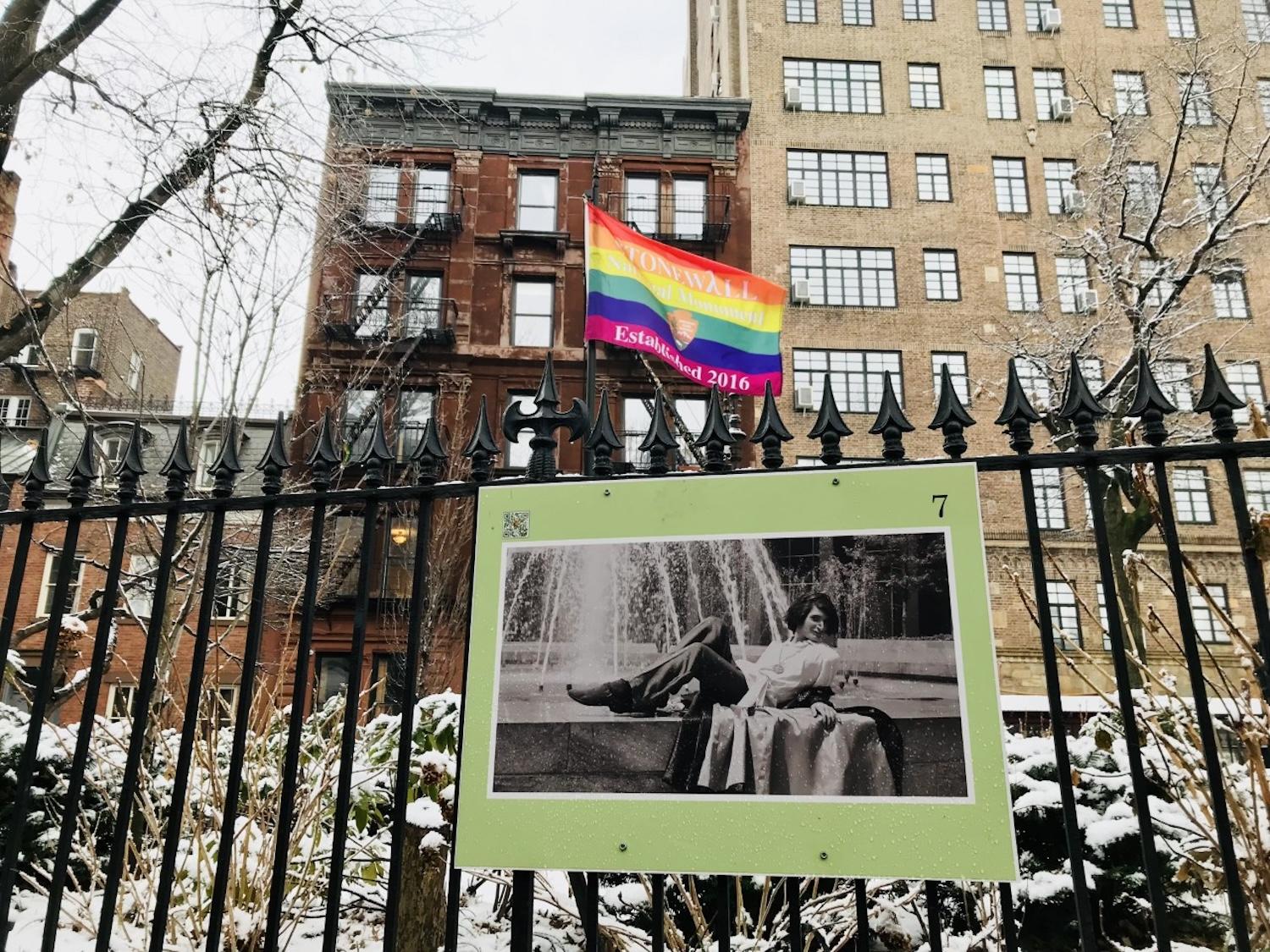
A historical photo in a fence exhibit at Stonewall National Monument shows Sylvia Rivera, who co-founded Street Transvestite Action Revolutionaries (STAR) with Marsha P. Johnson/Jennifer Bain
There have always been intersex and openly gay people, points out Burna, as well as people who use different pronouns.
“For me, and some of the rangers that work here, we will express our identify. You were noticing how complicated it is, how challenging the environment can be, with the sounds and the senses and all the activity on the street and so it often helps me to say I’m queer and neurodivergent. So what was really validating to me is people have come up to me after a tour and they’ll say `You used that word neurodivergent — I think I might be that as well. Would you be able to talk to me a little bit more about that?’ Some of the elder visitors would say `You just said you were queer I could never do that.’”
Burna loves watching how different generations react to the Stonewall story and to seeing a park ranger in a federal unform “talk about all American history.”
It has also been fun to reach out to other NPS sites as the 250th anniversary commemoration of American Independence approaches, and “find our connections and how we’re more related than we think.” The park service has pledged to elevate diverse stories for America 250 in 2026.
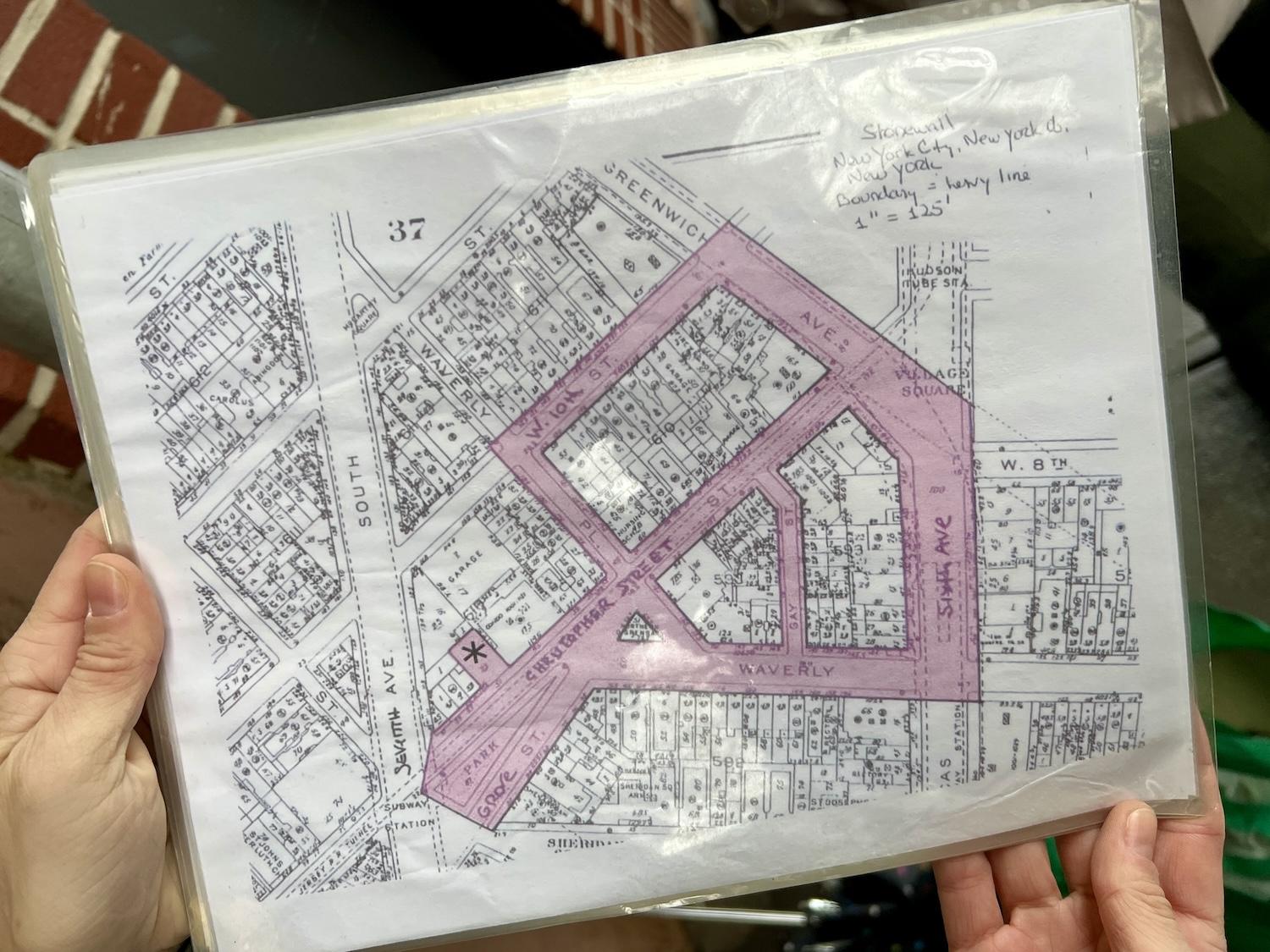
Stonewall National Monument lead ranger Julie Burna shows the laminated map she uses to show tours the area of Greenwich Village that is federally protected and can be interpreted/Jennifer Bain
When Burna leads public tours, she shares laminated photos as well as a map that that shows the historic area where the uprising protests spilled into the streets. The irregular street grid to the west of 6th Avenue is considered a relic of the 18th century. Narrow streets at odd angles to each other cause directional havoc. During the uprising, the labyrinthine street pattern helped the demonstrators — who knew the neighborhood — evade riot-control police who were not from the local precinct.
Stonewall is unique and draws a crowd that may not have visited many national parks before. Not only will the new visitor center reunite the 1969 footprint and red brick façade of the Stonewall Inn and help rangers better serve the public with the option of an indoor space, Tominsky believes it will “be a new meeting place.”
New York, she says, “is so complex and so rich and everywhere that you look there, every square inch of this city, there is an abundance of story that you can find if you just look around — and especially here in Christopher Park/Sheridan Square.”
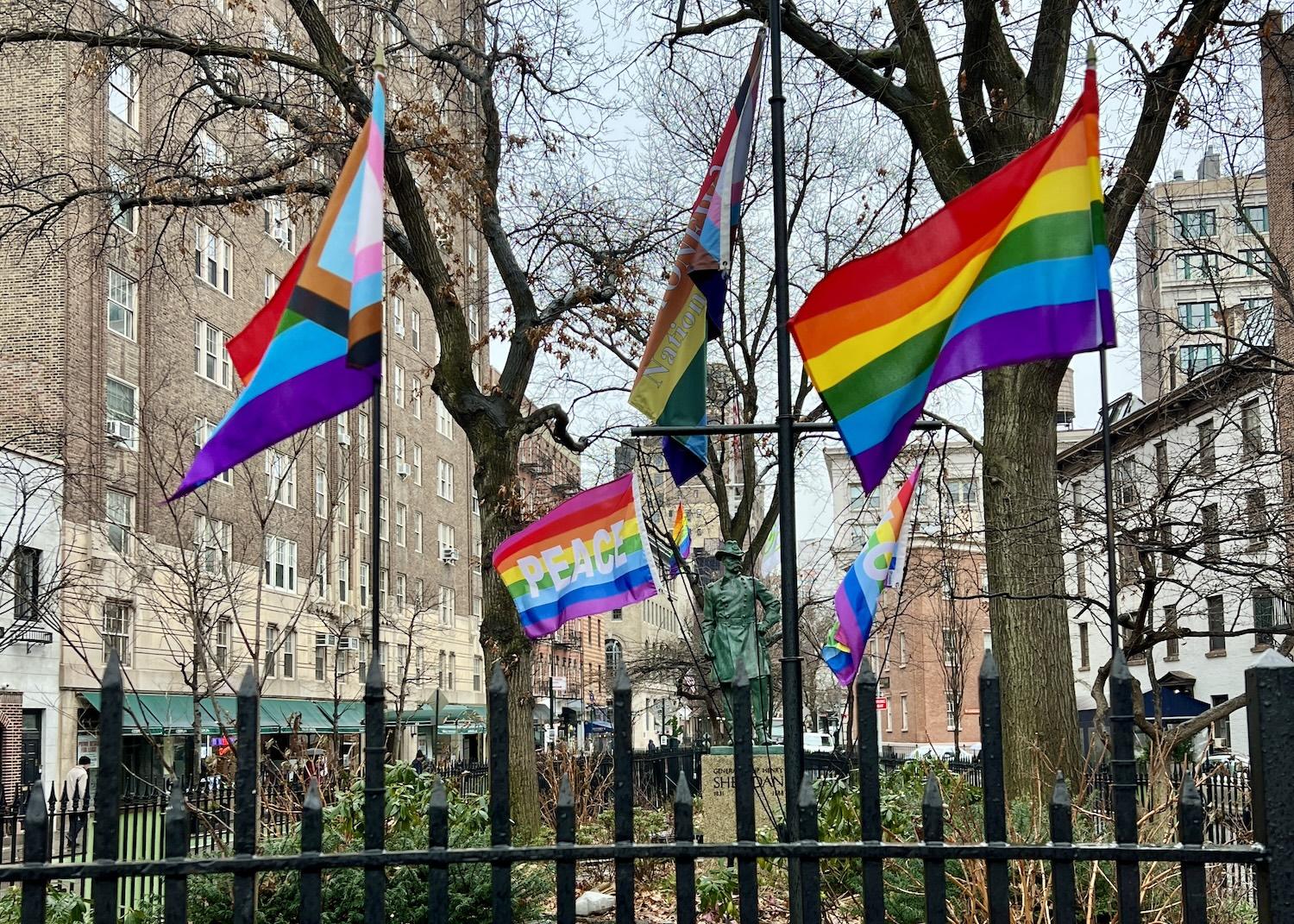
At Stonewall National Monument, various pride flags are shown fluttering in the wind in front of a statue of a Civil War general that was in Christopher Park before it was turned over to the National Park Service/Jennifer Bain





